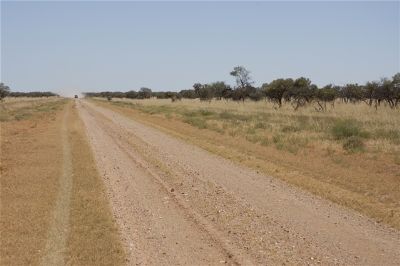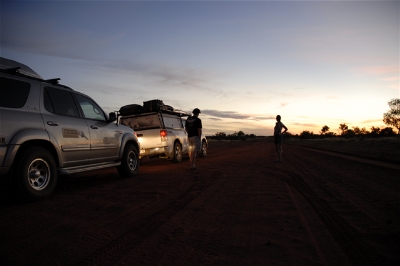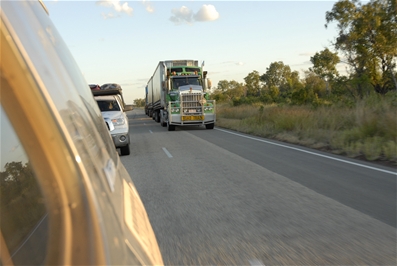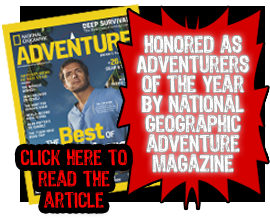Australia is a vast country that takes the better part of a day to go from Byron Bay to Roma, the gateway to outback Queensland. We met and had a chat with some nice people at the caravan park there who were kind enough to give us some advice on what to expect ahead and even send an e-mail to a popular nationwide radio talkshow host, convinced that what we were doing was worthy of a chat (more to come on that). A day and 1200 kilometers later and we were officially in the outback, a place that most Australians rarely travel through or to.
 Driving in the outback is full of surprises and is not for the ill prepared or unskilled driver. Once can expect to encounter many unusual things that you wouldn’t come close to seeing on an American road. We have receive more than fair warning about the kangaroos, wallabies, wombats and other creatures that seem to be attracted to the front end of your vehicle. This phenomenon is quite evident in the overwhelming number of cars and trucks in Australia with bull bars and grill guards. Everyone looks at the Tundra and Sequoia with awe and amazement, but maybe it is because we are traveling sanz roadkill protection. Apparently, it is not a matter of if, but simply when in terms of having a close encounter with the local wildlife on the road.
Driving in the outback is full of surprises and is not for the ill prepared or unskilled driver. Once can expect to encounter many unusual things that you wouldn’t come close to seeing on an American road. We have receive more than fair warning about the kangaroos, wallabies, wombats and other creatures that seem to be attracted to the front end of your vehicle. This phenomenon is quite evident in the overwhelming number of cars and trucks in Australia with bull bars and grill guards. Everyone looks at the Tundra and Sequoia with awe and amazement, but maybe it is because we are traveling sanz roadkill protection. Apparently, it is not a matter of if, but simply when in terms of having a close encounter with the local wildlife on the road.
Australia is also in the midst of one of its worst droughts on record and because the roads are built up with a crown, any water that does fall from the sky collects on the roadsides, feeding what greenery is able to survive and thus attracting animals from the bush to come and eat meters away from speeding traffic.  I am happy to say that we have put several thousand kilometers on the Toyotas, many of them at dusk when it is pretty risky to be on the road, all without incident… although we have had some very close calls with the roos in particular. Unfortunately, countless others were not as lucky and there are plenty of reminders on the side of the roads to assure you that the hazard is still very much there.
I am happy to say that we have put several thousand kilometers on the Toyotas, many of them at dusk when it is pretty risky to be on the road, all without incident… although we have had some very close calls with the roos in particular. Unfortunately, countless others were not as lucky and there are plenty of reminders on the side of the roads to assure you that the hazard is still very much there.
On top of keeping an eye out for wildlife, you also have to be vigilant about livestock wandering out on the road. Many of the highways, roads and tracks traverse through grazing land and if you think hitting a roo is bad, hitting a full size cow or bull is catastrophic. As I mentioned before, there is a bad drought here, so bad that stations (ranches for our American friends) are forced to drive their cattle down the sides of the roadways as they are the last haven for anything green in some parts of the outback. We have also had some close calls with cattle and have seen the evidence of those who were not as lucky.
As if worrying about wild and stock animals were not enough, throw the concept of a Road Train into the mix. In America, the open roads filled with the signs of commerce in the form of the 18 wheeler. Australia is no different, but instead of 18 wheelers there are Road Trains that have, well I didn’t even know how many wheels they have.  A Road Train consists of the tractor and anywhere from 3 to 5 FULL SIZE trailers. These Road Trains are on average 50 meters (150 feet) long and passing one of these behemoths, trailers weaving from side to side on single lane roads is a true test of nerves and guts. On the singletrack dirt outback tracks you can see Road Trains coming from miles away as a result of the dust they kick up and when you see one coming your way you better pull off to the side of the road because they won’t.
A Road Train consists of the tractor and anywhere from 3 to 5 FULL SIZE trailers. These Road Trains are on average 50 meters (150 feet) long and passing one of these behemoths, trailers weaving from side to side on single lane roads is a true test of nerves and guts. On the singletrack dirt outback tracks you can see Road Trains coming from miles away as a result of the dust they kick up and when you see one coming your way you better pull off to the side of the road because they won’t.
When you do have the time to take your mind off of the hazards, the outback has some amazing scenery. Scenery that is truly unique to this part of the world and it just makes driving here the adventure that we were looking for. But something tells me animals, wild or domestic, and Road Trains are just the tip of the iceberg of what lies ahead down The World by Road.
